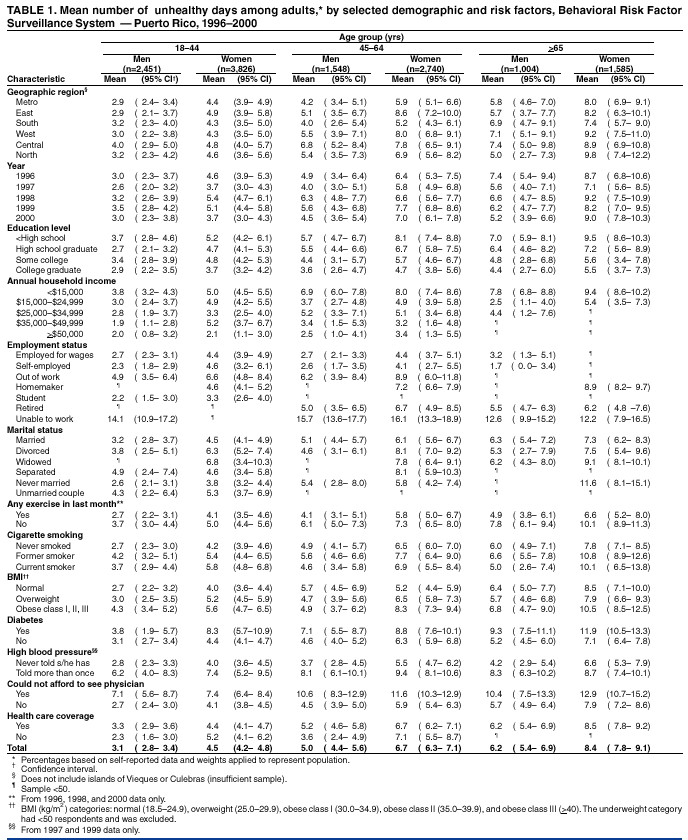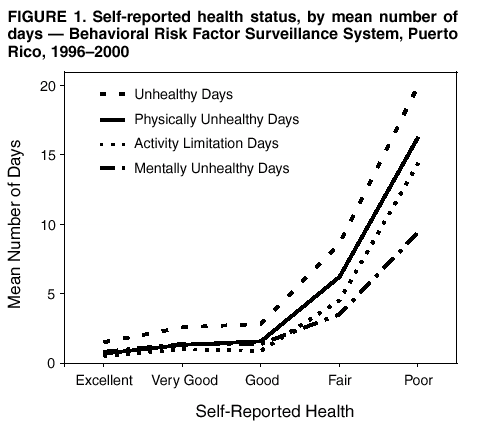
|

Health-Related Quality of Life --- Puerto Rico, 1996--2000
Although a number of studies have been made to determine the health-related quality of life (HRQOL) of persons living
in the United States, no overall assessment of HRQOL has been conducted previously for residents of Puerto Rico
(1). To determine the HRQOL of adults living in Puerto Rico, during 1996--2000, as part of the Behavioral Risk Factor
Surveillance System (BRFSS), interviews were conducted in Spanish with a representative sample of Puerto Rican adults
(2). Older women, persons with less education or lower income, persons unable to work, and those who were overweight or who
had diabetes or high blood pressure reported more days for which they were physically or mentally unhealthy during the 30
days preceding the survey. Interventions designed to reach these vulnerable, demographic, socioeconomic, and behavioral
risk groups might help adults in Puerto Rico increase their quality and years of healthy life and eliminate health disparities.
BRFSS is an ongoing, random-digit--dialed telephone survey of the noninstitutionalized civilian population aged
>18 years that is conducted in the 50 U.S. states, the District of Columbia, and Puerto Rico. Data were weighted to reflect the age
and sex distribution of Puerto Rico's estimated population during each survey year. In Puerto Rico, a Spanish-language version
of the English-language BRFSS survey was administered
(2). HRQOL items included self-rated health status (i.e., excellent,
very good, good, fair, or poor) and the number of days during the 30 days preceding the survey when physical health (i.e.,
physical illness or injury) or mental health (i.e., stress, depression, or emotional problems) was not good and usual activity (i.e.,
self-care, work, or recreation) was limited as a result of poor physical or mental health. Unhealthy days were defined as the
total number of days for which the respondent reported feeling either physically or mentally unhealthy, up to a maximum of
30
days per respondent. Means and 95% confidence intervals (CIs) were calculated using SUDAAN to account for the
complex BRFSS survey design.
During 1996--2000, a total of 13,686 adults in Puerto Rico participated in BRFSS. The average response rate was
91.8% (range: 89.4%--93.2%)*. An estimated 34% (95% CI=33.1%--35.0%) of adults in Puerto Rico reported fair or poor
health. Levels of self-rated health in adults in Puerto Rico did not differ by sex. On average, adults with fair or poor health
reported substantially more days for which they were either physically or mentally unhealthy or limited in activity than those
whose health status was good, very good, or excellent (Figure 1). Among persons rating their health status as fair or poor,
younger adults were more likely than older adults to report mentally unhealthy days.
Men aged 18--44 years living in the island's metropolitan or eastern regions reported the fewest (2.9) unhealthy days,
and women aged >65 years living in the northern region reported the most (9.8) unhealthy days (Table 1). The number of
self-reported unhealthy days peaked in 1998 and 1999 but did not change substantially. Overall, the mean number of
activity limitation days was substantially higher during 1998--2000 (2.7 days; 95% CI=2.5--2.9) than during 1996--1997 (1.7
days; 95% CI=1.5--1.9). The number of unhealthy days reported was significantly higher for women aged 18--44 years,
45--64 years, and >65 years than for men in the same three age groups by 1.4 days, 1.7 days, and 2.2 days, respectively (Table 1).
Fewer unhealthy days were reported by respondents with higher education, income, and employment levels than
less educated, poorer, and unemployed respondents. By educational attainment, mean unhealthy days ranged from 2.7 days
for men aged 18--44 years with a high school education to 9.5 days for women aged
>65 years who did not complete high school. By household income, the lowest mean for unhealthy days was 1.9 days for men aged 18--44 years with
household incomes of $35,000--$49,999; the highest mean for unhealthy days was 9.4 days for women aged
>65 years with incomes <$15,000 per year. By employment status, the lowest mean (1.7 days) was for self-employed men aged
>65 years, and the highest (16.1 days) was for women aged 45--64 years who were unable to work.
Respondents who exercised during the month preceding the survey or who had never smoked cigarettes reported
fewer unhealthy days than those who did not exercise or who had smoked. Those with normal body mass index (BMI) usually
had fewer unhealthy days than those who were obese (BMI
[kg/m2] >30). Persons in all age groups with diabetes had
significantly more unhealthy days than those without diabetes. Persons who had been told two or more times by a health-care provider
that they had high blood pressure reported significantly more unhealthy days in all age groups than those who not been told
they had high blood pressure. Those who could not afford to see a health-care provider reported more unhealthy days than
those who could afford to see one, but the 9% without health-care coverage had about the same mean number of unhealthy days
as those with health-care coverage.
Reported by: Y Cintron, Department of Health, Office of the Assistant Secretary for Health Promotion, San Juan, Puerto Rico. R Kobau,
MPH, Div of Adult and Community Health, National Center for Chronic Disease Prevention and Health Promotion, CDC.
Editorial Note:
The findings in this report indicate that there are substantial differences in HRQOL among subgroups
in Puerto Rico. Socioeconomic and health indicators for Puerto Rico have improved substantially since 1970 as
economic development has transformed a primarily agricultural economy to one based on manufacturing and services
(3). Since 1993, Puerto Rico also has privatized public health facilities and instituted managed competition to extend health
insurance coverage to the uninsured. However, the continued low per capita income in Puerto Rico adversely affects Puerto
Ricans' mental and physical health and their overall quality of life
(3). The findings in this report reflect the impact of
lower socioeconomic status on HRQOL. In some cases, low HRQOL might affect socioeconomic status (e.g., by reducing
one's productivity and associated earnings).
Puerto Rican adults reported having fewer unhealthy days but substantially worse self-rated health than U.S. adults
(2,4). Lower self-reported health status among Puerto Ricans, both those living in Puerto Rico and those living on the
U.S. mainland, has in part been attributed to somatization (i.e., reported physical symptoms in the absence of physical
pathology as a method of expressing psychosocial problems)
(5), the stresses of acculturation (6), or
ataque de nervios (a culturally meaningful expression addressing the experience of suffering either personal or social loss)
(7).
Persons with fair or poor health status reported more days for which they were physically and/or mentally unhealthy
or limited in activity than did persons whose health status was good, very good, or excellent. This supports the construct
validity of the HRQOL measures in the Puerto Rican population: the two constructs---self-rated health and reported unhealthy
days---were associated in a consistent and expected manner
(8).
The findings in this report are subject to at least four limitations. First, households without telephones and those with
only cellular phones were excluded from the sampling frame
(2). Second, BRFSS excludes an unknown number of persons
in institutions and all persons aged <18 years. Third, BRFSS might underrepresent those with a severe impairment because
time and functional capacity are required to participate in BRFSS. Finally, the reasons why persons reported worse health status
are unclear because BRFSS does not assess the effects of cultural expressions of distress, acculturative stress, or other
sociocultural and environmental factors that influence health.
The results of this analysis indicate that the Spanish-language HRQOL questions might be useful for other
Spanish-speaking groups in the U.S. and in other Spanish-speaking countries. Differences in HRQOL in
demographic, socioeconomic, and behavioral risk subgroups in Puerto Rico reflect the influence of individual biology and behavior, as
well as social and environmental factors, on HRQOL
(9). Policy makers can track HRQOL to identify groups with unmet
health needs (10). Public health interventions designed to reach vulnerable demographic, socioeconomic, and behavioral risk
groups with poor HRQOL might help adults in Puerto Rico to increase their quality and years of healthy life and eliminate
health disparities (9).
References
- CDC. Health-related quality of life. Available at http://www.cdc.gov/hrqol. Accessed February 2002.
- CDC. Behavioral Risk Factor Surveillance System. Available at http://www.cdc.gov/nccdphp/brfss. Accessed February 2002.
- Pan American Health Organization. Health sector reform: the case of Puerto Rico. Washington, DC: Division of Health Systems and
Services Development, World Health Organization, September 1998.
- CDC. Measuring healthy days: population assessment of health-related quality of life. Atlanta, Georgia: US Department of Health and
Human Services, Public Health Service, CDC, November 2000.
- Angel R, Guarnaccia PJ. Mind, body, and culture: somatization among Hispanics. Soc Sci Med 1989;28:1229--38.
- Cortes DE, Rogler LH. Health status and acculturation among Puerto Ricans in New York City. J Gen Cult Health 1996;1:267--76.
- Guarnaccia PJ, Rivera M, Franco F, Neighbors C. The experiences of ataques de nervios: towards an anthropology of emotions in Puerto Rico.
Cult Med Psychiatry 1996;20:343--67.
- Spector PE. Summated rating scale construction. Newbury Park, California: Sage University. Sage University paper series on
Qualitative Applications in the Social Sciences, (no. 82).
- US Department of Health and Human Services. Healthy people 2010, understanding and improving health 2nd ed. Washington, DC:
U.S. Government Printing Office, November 2000, 6.
- Broyles RW, McAnley WJ, Baird-Holmes D. The medically vulnerable: their health risks, health status, and use of physician care. Journal of
Health Care for the Poor and Underserved 1999;10(2):186--200.
* This rate is the upper bound response rate, which includes completed interviews, refusals, and terminations. The resulting estimate reflects the cooperation
of respondents contacted and is not affected by difference in telephone sampling efficiency. The response rates for 1996 and 2000 are unavailable. Council
of American Survey Research Organizations response rates were 88.9% in 1997, 76.7% in 1998, and 69.5% in 1999 (Source: BRFSS 1998 and 1999,
Summary Quality Control Report).
Table 1

Return to top.
Figure 1

Return to top.
Use of trade names and commercial sources is for identification only and does not imply endorsement by the U.S. Department of
Health and Human Services.
References to non-CDC sites on the Internet are
provided as a service to MMWR readers and do not constitute or imply
endorsement of these organizations or their programs by CDC or the U.S.
Department of Health and Human Services. CDC is not responsible for the content
of pages found at these sites. |
Disclaimer
All MMWR HTML versions of articles are electronic conversions from ASCII text
into HTML. This conversion may have resulted in character translation or format errors in the HTML version.
Users should not rely on this HTML document, but are referred to the electronic PDF version and/or
the original MMWR paper copy for the official text, figures, and tables.
An original paper copy of this issue can be obtained from the Superintendent of Documents,
U.S. Government Printing Office (GPO), Washington, DC 20402-9371; telephone: (202) 512-1800.
Contact GPO for current prices.
**Questions or messages regarding errors in formatting should be addressed to
mmwrq@cdc.gov.
Page converted: 2/28/2002
|

|
